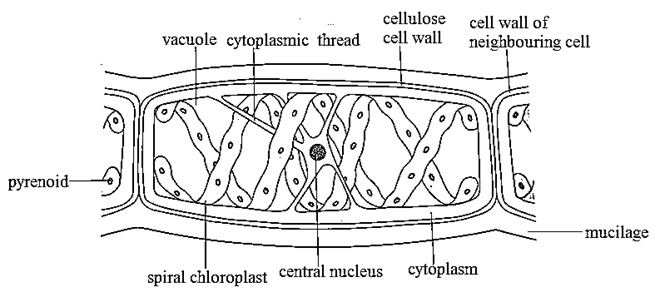Essay And Obj Nabteb GCE Biology 2022 Questions And Answers
Welcome to zamgist, where we posted Essay and Obj nabteb gce biology 2022 questions and answers which will hold on today 29 November 2022.
Nabteb gce biology Essay and Objective 2022
BIOLOGY-OBJ–
1-10: CBACBADCBA
11-20: BCACBADBDA
21-30: ABDAADACAC
31-40: DDBBCDCBBD
41-50: BDDCBBADCA
Completed!!!
••••••••••••••••••••••••••••••••••••••••••••••••••••
INSTRUCTION: ANSWER FOUR(4) QUESTIONS IN ONLY, AT LEAST ONE QUESTION FROM EACH PART
PART I: INTRODUCTORY BIOLOGY
(1a)

(1bi)
(i) Euglena moves by flagella whereas Amoeba moves by pseudopodia
(ii) Euglena has a definite shape while Amoeba does not have a defined shape
(iii) Euglena undergoes photosynthesis while Amoeba does not under photosynthesis
(iv) Euglena lives in freshwater and saltwater whereas Amoeba is free-living in damp environment
(1bii)
(i) They can pass through filters, through which bacteria cannot pass
(ii) They do not increase in size
(iii) They are ultra microscopic and can only be visualised under electron microscope
••••••••••••••••••••••••••••••••••••••••••••••••
_PART II: FLOWERING PLANTS AND SOIL SCIENCE_
(2ai)
Soil conservation is the preventing of soil loss from erosion or reduced fertility caused by over usage, acidification, salinization or other chemical soil contamination
(2aii)
(i) Fixing atmospheric nitrogen
(ii) Releasing nutrients from organic matter
(iii) Degrading pesticides
(iv) Improving soil structure
(v) Controlling pathogens
(2bi)
(i) Berry: Strawberries, blueberries
(ii) Drupe: Mango, Almond
(iii) Caryopsis: Wheat, Rice
(iv) Cypsela: Sunflower, Tridax
••••••••••••••••••••••••••••••••••••••••••••••••
(3a)
(i) Continuous cropping:- This involves the continuous cultivation of a particular land which results in to exhaustion of the soil, reduces mineral nutrients of the soil thereby causing imbalance in the ecosystem.
(ii) Bush burning – Destroys both the producers and consumers in an ecosystem, depletes the essential nutrients, reduces water holding capacity of the soil, low support of plant and animals. iT Even destroys the microbial flora and fauna or micro-organisms in the soil. Also encourages soil erosion.
(iii) Use of chemicals, e.g. pesticides, herbicides and fungicides which are used to control plants and animals pests generally affect or destroy other plants and animals in the environment.
(3bi)
Placentation is defined as the arrangement of the placenta in the ovary of a flower. The placenta connects the ovules with the wall of the ovary.
(3bi)
(i) Marginal placentation: Pea
(ii) Axile placentation: Tomato
(iii) Parietal placentation: Cucumber
(iv) Basal placentation: Sunflower
Also Read:�Nabteb 2023/2024 Expo Questions and Answers for All Subjects
••••••••••••••••••••••••••••••••••••••••••••••••
_PART III: ANIMAL BIOLOGY_
(4ai)
(i) Plasma
(ii) Red blood cells
(iii) White blood cells
(iv) Platelets
(4aii)
When the blood vessels is damaged/exposed to the atmosphere, the platelet in the blood secretes an enzyme called thrombokinase. This enzyme actually convert inactive prothrombine to active thrombine. This active thrombine will now convert soluble fibrinogen into insoluble fibrin in the presence of Ca2+(calcium ion). The thread like fibrin are now trapped by the cells of the wound, which now form a network on the surface of the wound to form clot.
(4bi)
Hormones are chemical messengers that are secreted directly into the blood, which carries them to organs and tissues of the body to exert their functions.
(4bii)
(i) Prolactin: It helps in foetal lung development.
(ii) Oxytocin: It stimulate contractions of breast tissue to aid in lactation after childbirth.
(iii) Oestrogen: It is responsible for the development of breasts in puberty and the growth of uterus lining during the menstrual cycle.
(iv) Adrenaline: It triggers the blood vessels to contract to re-direct blood toward major muscle groups, including the heart and lungs.
(v) Testosterone: It Promotes the development and growth of the penis, testicles, scrotum, and sexual secretory glands.
••••••••••••••••••••••••••••••••••••••••••••••••
(5ai)
(5aii)
Reflex action processes, for example, when a person suddenly and unknowingly touches a hot object can be as follows;
(i) On touching the hot object, the nerve ending of a sense organ(the skin) is stimulated.
(ii) The impulse are transmitted through the sensory neurone passing through the dorsal root into the spinal cord.
(iii) From here, the impulses are relayed via the synapses into the intermediate neurone through another synapse to the motor or efferent neurone.
(iv) This passes through the ventral root or he motor organ which brings about a response. The impulse causes the muscle of the hand to contract, thereby removing the hand from the painful stimulus and preventing injury to the tissue
(5b)
(i) Voluntary action are under control of ones will, whereas reflex action are spontaneous involuntary, nerve-mediated activity produced at the unconscious level by stimulating specific receptors.
(ii) In the voluntary action, only motor nerve and effector organs are involved, whereas reflex action involves both sensory and motor nerves and sensory and effector organs.
(iii) Voluntary action responses originate in the brain and are transported to the effector organs via spinal cord whereas reflex action responses originate in the spinal cord.
(5ci)
(i) Blinking of the eyes
(ii) Jerking of the kneel
(5cii)
(i) Singing
(ii) Walking
••••••••••••••••••••••••••••••••••••••••••••••••
_PART IV: GENETICS AND ECOLOGY_
(6a)
(i) Genotype: This is the genetic make-up of genes in an organism that is independent of the environment
(ii) Genes: These are units of heredity located in the chromosomes which are responsible for the coding of a particular protein to transfer trait or character from parents to offspring.
(iii) Alleles: These are pairs or series of genes on a chromosome that determine the hereditary characteristics.
(6bi)
Food preservation is the procedure by which food is treated and handled to stop or slow down food spoilage, loss of quality, edibility, or nutritional value and thus allow for longer food storage.
(6bii)
(i) Salting
(ii) Refrigeration
(iii) Drying
(iv) Smoking
(v) Chemicals
Completed!